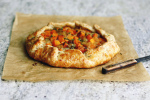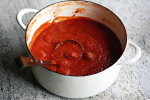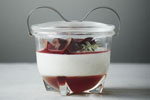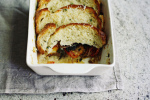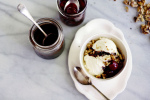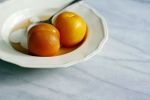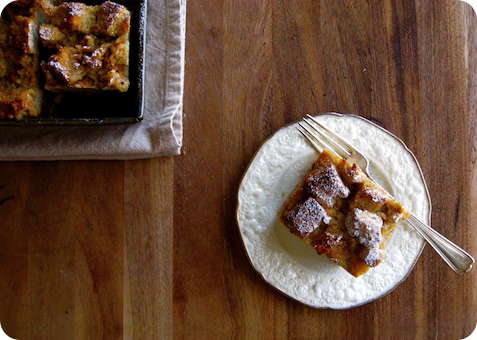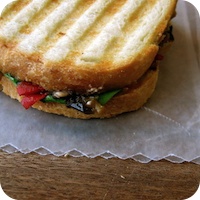Rah-rah-sis-boom-bah
 Tuesday, March 31, 2009 at 1:34PM
Tuesday, March 31, 2009 at 1:34PM 
[Thursday, March 26, 2009: Due to an under-the-weather little one, I will not be able to post today . Until he's feeling better, here is a sneak peak at what we've been enjoying this week - a luscious Grapefruit Tart with a buttery, shortbread crust. Just a bit of puckery-brightness for these early spring days.
Back soon.
Tuesday, March 31, 2009: Everyone is all better, and so I am back. Thanks for all your concern and well-wishes, and for keeping a spot warm for me.]
Orange peel. Air that is sugary sweet and heavy, ripe with moisture and the scent of citrus. I shut my eyes and inhale, swallowing whole.
Its February and I am in my parents' kitchen.
For years, my Mum made marmalade; each time turning to the same book, using the same recipe for as long as I can remember. Stains and smears have turned the page translucent in places, smudging the penciled notes along the margins.
The ceremony of marmalade making took the day. The speckled charcoal pot, used only for canning, appeared from the depths of cupboards. Sterilized jars lined up like soldiers on the counter, gleaming, waiting to be of service. I have a mix of memories of the procedure; the infinite boiling, reducing, concentrating of flavours, the endless task of cutting the thin peel into even thinner strips, staining my nails in the process.
And although at the time I did not much care for marmalade, the notion of those jars is still one of my strongest culinary memories and present-day aspirations. What care was there of winter when there was such warmth in the kitchen, such delicious bounty to be enjoyed?
While the calendar may (almost) read April, it still (almost) feels like February here. At best, early March. Maybe.
The sun may be warm but the wind is not; it still breathes bitterly against our faces each morning, sending me shivering back into the warmth of the house and reaching for a scarf. Just the other day I was greeted with snow in the moments just after sunrise; it cascaded delicately, like icing sugar upon a cake rather than a true snowfall, but it was frozen nonetheless. This morning there was no snow, thank goodness, but the grass was frost-tipped and blue in the early light.
Spring is dragging her feet.
But, there is hope. There are the teeniest buds on our lilac tree; tiny, perfect little bundled fists of green, holding within their grasp the promise of warm days to come. The afternoon light has changed its character, doffing its winter garb of blue-grey hues for warmer shades of palest flax. And while I wait, as patiently as I can, for local rhubarb and asparagus and, sigh, berries to make their way to market, at least I can count on citrus to bring even more sunshine to our day.
Bold and boisterous on the tongue, citrus is rah-rah-sis-boom-bah blithe, full of cheer and high kicks. Citrus fruits are sharp and spry, marching merrily ahead as spring lags behind, with enough pep in their step to wake our palates from the sedative effect of a season's worth of comforting richness.
I was looking for a tag-along companion for a Sunday brunch invite, something that could add some brilliance to what could be a gray morning. Citrus was surely the ticket, and I wanted to journey on the path of least-resistance; some quick Saturday baking and Sunday primping, with little worry and few opportunities to be lead astray.
I wholly ignored the option of sometimes-temperamental shortcrust pastry, eyeing in its stead a forgiving shortbread crust. I passed on the idea of a persnickety curd for its filling; with its demands of patient stirring over gentle heat and its abject fear of overcooking, a curd can be such the little fusspot. Not what I was looking for in a brunch guest.
A grapefruit-modified version of a traditional Key lime filling was my choice, whisked together and briefly baked, it demanded only the slightest attention; its presence fit perfectly in the bleary-eyed pottering about of Sunday morning.
Yellow upon yellow, this tart speaks of brightness in golden tones. The floral notes of Ruby Red grapefruit are accented by twangy lemon, and tempered by creamy-sweet condensed milk. The shortbread crust is the perfect foil for the citrus, buttery against all the tang of the filling.
So thoroughly-cheered was I, I (almost) felt prepared to be patient as I wait for spring's arrival. Almost.
Grapefruit tart with shortbread crust
Ingredients for the crust
1 1/2 cups all-purpose flour
1/4 teaspoon salt
3/4 cup (1 1/2 sticks) unsalted butter, room temperature
1/2 cup confectioners' sugar
2 large egg yolks, room temperature
2-3 teaspoons heavy cream
Ingredients for the filling
4 large egg yolks
1 can sweetened condensed milk
2 teaspoons grated grapefruit zest
1 teaspoon grated lemon zest
1/2 cup freshly squeezed grapefruit juice (preferably Ruby Red)
1 1/2 tablespoons freshly squeezed lemon juice
1/8 teaspoon salt
Prepare the crust first. Whisk together the flour and salt in a medium bowl and set aside. In the bowl of a stand mixer with the paddle attachment, or in a large bowl using a hand mixer, cream together the butter and sugar on low until light and well blended.
Add the eggs yolks, one at a time, beating well after each addition. Scrape down the sides of the bowl as needed. Add the flour and mix until almost blended. Slowly add 2 teaspoons of cream, checking if the dough has come together. If it is still a bit dry, add the rest. Stop mixing as soon as there is no longer flour visible.
Turn the dough out onto a piece of plastic wrap, using the wrap to shape the dough into a flattened disk. Wrap tightly, then refrigerate for 1 hour.
After the dough has chilled, lightly flour your work surface. Roll out the dough into a 1/4-inch thick circle, about 12 inches in diameter. On a parchment-lined baking sheet, drape the dough over a 9-inch flan ring, fitting the dough gently and pressing it into the edges. Chill the dough for 10 minutes.
Using a sharp paring knife, trim the dough so that it is flush with the rim. Return the tart shell to the refrigerator for 30 minutes to firm up and chill thoroughly.
Preheat an oven to 375°F (190°C). Line the tart shell with parchment, allowing a 1-inch overhand. Fill lined shell with pie weights and bake until the pastry's edges are beginning to colour, about 15 minutes. Remove parchment and weights, using the overhang of paper to assist. Continue baking until the pastry is light golden all over, about eight minutes more. Remove from the oven and transfer to a wire rack to cool completely (still on parchment lined baking sheet).
Turn the oven down to 350°F (175°C).
In the bowl of a stand mixer with the whisk attachment, or in a medium bowl with a hand mixer or whisk, beat the yolks on medium-high speed until fluffy and pale, about 3 minutes. Add condensed milk, zests, juices and salt, and beat to combine, scraping down side of bowl as needed.
Pour the filling into the cooled prepared tart shell and bake until just set, about 10 minutes. Still on its parchment, transfer the tart to a wire rack. Cool completely, then loosely cover in clingfilm and refrigerate for at least 1 hour or up to overnight.
Allow the tart to sit at room temperature for about 10 minutes before serving; remove the flan ring and garnish with some softly-whipped cream, crème Anglaise or simply with a dusting of confectioners' sugar.
Makes one 9-inch tart, serving 12.
Notes:
• Alternatively, use the leftover egg whites to top the tart with a torched Swiss meringue.
• The tart as shown was baked in a 10-inch quiche pan with extra-deeps sides and a removable bottom. The amount of filling and pastry require a deeper capacity.


